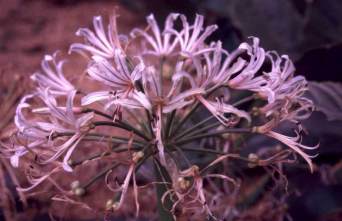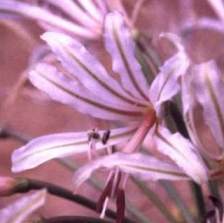Nerine laticoma
Nerine laticoma (Ker Gawl.) T. Durand & Schinz
Family: Amaryllidaceae
Common names: vleilelie, gifbol, jeukui, seeroogblom (Afr.)
Introduction
This is a summer-growing Nerine, one of a genus of beautiful geophytes endemic to southern Africa.

Description
Description
Nerine laticoma includes several forms which were previously recognized as separate species (N. duparquetiana, N. falcata and N. lucida). This species has a tuft of four to eight broad, strap-shaped leaves which can grow to 300 x 15 mm. The bulb is large and deep-seated.

N. laticoma bears a large, spherical inflorescence of white, or pale to rose pink, irregular flowers. The perianth segments grow to 45 x 5 mm and have a pinkish brown, median keel. In one form the segments are strongly recurved. Flowers are borne any time between early January and late March and are short-lived. Flowers are followed by a papery capsule which is the fruit and contains one to many round, or irregularly-shaped, fleshy seeds. Nerine species hybridize easily so, if several species are grown in close proximity, the seed is likely to yield garden hybrids.
Distribution and habitat
Distribution description
Nerine laticoma occurs in a broad band stretching from the dry inland parts of Namibia eastwards and southwards through southern Botswana, Limpopo, Gauteng, the North-West, Northern Cape, Free State and Lesotho. It usually occurs in large colonies on deep, red, sandy soils.
Derivation of name and historical aspects
History
The name Nerine refers to a mythological guardian sea nymph sent by the Roman goddess Venus to rescue Vasco da Gama's armada en route to India. The epithet laticoma refers to the broad tuft of leaves. Nerine is endemic to southern Africa and comprises about 25 species; widely distributed throughout the region, the main concentration is in the summer rainfall areas, especially in the Eastern Cape.
Ecology
Ecology
Nerine laticoma is a summer-growing plant. It survives the cold, dry winters by going dormant. New leaves emerge from the storage organ, the large bulb, in spring when conditions for growth improve.
Uses
Use
Nerine bulbs contain alkaloids, and Nerine laticoma has the common name gifbol (Afr.), but no traditional uses are recorded for this species. Together with other species such as Nerine sarniensis and Nerine masoniorum, these plants are valued primarily for their horticultural potential.
Growing Nerine laticoma
Grow
Although very attractive, this species can be difficult to get to flower in cultivation. Plants can be grown in deep pots or in a well-drained rockery in suitable climates. These plants require very high summer temperatures and a completely dry winter period to thrive. Bulbs should be planted with their necks just below soil level. Plant in a sandy medium with a little compost and water heavily in summer while the plant is growing, but allow the soil to dry out between waterings.
Nerine laticoma does not produce offsets, but is easily grown from seed. When the seed is ripe, sow it in deep seed trays in a sandy medium. Just cover the seed. Leave the seedlings in the trays for at least two seasons, after which they can be grown on in larger containers, or planted out in the garden. The broad-leafed N. laticoma takes at least five years to flower for the first time when grown from seed.
Watch out for attacks by the amaryllis lily borer and mealy bugs. Slugs and snails can do great damage to the leaves, and are responsible for transmitting viral disease. Remove the pests by hand or use a bait or repellent such as broken eggshells or tobacco dust in a ring around the base of the plants. Thrips, a minute, narrow, sucking insect can also attack the plant. They are most often found on the undersides of the leaves, resulting in characteristic white streaks. Control severe infestations with a pesticide spray.
References
- Duncan, G. 2002. Grow nerines. Kirstenbosch Gardening Series. National Botanical Institute, Cape Town.
- Du Plessis, N. & Duncan, G. 1989. Bulbous plants of southern Africa. A guide to their cultivation and propagation. Tafelberg, Cape Town.
Credits
Shireen Harris
Free State NBG
October 2003
Plant Attributes:
Plant Type: Bulb
SA Distribution: Free State, Limpopo, North West, Northern Cape
Soil type: Sandy
Flowering season: Late Summer, Autumn
PH: Alkaline, Neutral
Flower colour: White, Pink
Aspect: Full Sun
Gardening skill: Easy
Special Features:
Horticultural zones








Rate this article
Article well written and informative
Rate this plant
Is this an interesting plant?
Login to add your Comment
Back to topNot registered yet? Click here to register.